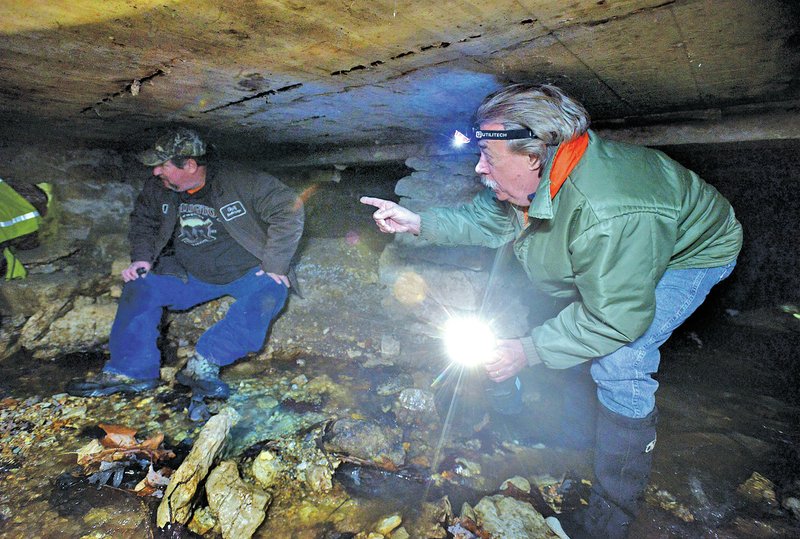Correction: A photo in Thursday’s editions showed a tunnel underneath downtown Eureka Springs between building foundations. The photo caption was incorrect; the area shown in the photo was separate from a collapsed portion of tunnel discovered Wednesday.
EUREKA SPRINGS -- A drainage tunnel in this tourist town has collapsed, further undermining the integrity of two parking spaces in a lot above, next to the historic Auditorium on Main Street.
Dwayne Allen, the city's Public Works director, described it as a "total collapse," but Mayor Robert D. "Butch" Berry said water was getting through.
"It's worse than what it was, but it's not as bad as it could be," Berry said.
Berry, Allen and half a dozen others toured the tunnel Wednesday, going down through a manhole on Main Street. They sloshed through running water and duckwalked in sections with low clearance until they could go no farther. The collapse was just beyond a section where two large rocks angle down from the ceiling, worrying city officials for several years.
Dee Purkeypile, a dam engineer and former city alderman, said the tunnel was "a lot worse" than he expected.
"There were timbers supporting the roof," he said. "They've collapsed. The rock has collapsed, and you can see fine material on top of the rocks. So all the material will continue to be washed out of there with every rainfall. So it's not going to get any better. It's destabilizing."
Debris in the section of the tunnel that collapsed was about 4 feet high. The damaged section is about 10 feet long and appears to be underneath a sidewalk on the southwest side of The Auditorium.
Several years ago, a section of the sidewalk sank by 3 inches. Two parking spaces next to the Auditorium have been roped off for the past four years as a safety precaution, although The Auditorium -- built in 1929 -- appears to be unaffected by the tunnel collapse, Allen said.
A century ago, several buildings along the southeast side of Main Street were built over the eastern branch of Leatherwood Creek, which flows for about 1,500 feet through a tunnel underneath buildings and parking lots. The top of the tunnel is about 12 feet below the surface. In places, the tunnel is large enough for people to walk upright through, as the group did Tuesday.
In 2011, McClellan Engineers of Fayetteville estimated it would cost $200,000 to repair the sagging tunnel.
Allen said Wednesday he thought it might be possible to repair the collapsed tunnel for half that amount.
But the inspection also revealed another problem: Part of the limestone wall of the tunnel farther to the southwest had been "undermined," Purkeypile said.
Rainfall washes Boone chert gravel from the hillsides into Leatherwood Creek. The churning, jagged chert scours away at the limestone, eroding it, Purkeypile said.
The result is underneath the parking lot between The Auditorium and the Carroll County Courthouse is a 10-foot-long section of limestone carved away beneath the surface. The eroded part is about 10 inches tall and a foot wide.
After hearing about that Wednesday morning, Allen said the city will have to bid out the repair work. It's more than the Public Works Department can handle, he said.
At a City Council meeting Jan. 12, aldermen discussed putting a reinforced concrete slab over the two parking spaces in the lot, but they didn't know about the collapsed tunnel.
Allen said he will confer with Purkeypile and others, and present options to the council at Monday's regular meeting.
Eureka Springs, which is built into the sides of cliffs, has some tunnels for drainage and others that may have been created when streets were elevated a century ago.
Sinkholes have historically been a problem in Eureka Springs. Fifteen years ago, a 20-foot-wide, 18-foot-deep sinkhole swallowed most of a vehicle parked on pavement above it.
In 2010, the parking lot problem became an issue because of disputes over who would pay for repairs.
Carroll County owns the lot. The city leases it from the county and has agreed in its contract to maintain a "hard surface and good repair."
County Judge Sam Barr said Tuesday he believed in 2010 and still believes the parking lot repairs are the city's responsibility.
At the Jan. 12 council meeting, Alderman Mickey Schneider said the city isn't responsible for the collapsing tunnel.
"We're responsible for the surface, not below the surface," she told the council.
But Berry, who became mayor this month, said, "It's our responsibility."
Alderman Terry McClung noted the city was losing revenue on the spaces, which are in a prominent location for tourists and people going to The Auditorium or courthouse.
Metered parking spaces in Eureka Springs take in an average of about $1,300 per year, said Lonnie Clark, the city's finance director.
Purkeypile said the parking lot problems have been sort of "out of sight, out of mind" for the past four years, but Wednesday's tunnel inspection provided insight that will make repairs more urgent.
Carroll County has an Eastern District courthouse in Berryville and a Western District courthouse in Eureka Springs. The city leases office space in the Eureka Springs courthouse, where the mayor's office is located.
Allen said if the collapse isn't repaired before spring rain, water will back up and some buildings could flood, including the courthouse basement.
NW News on 01/22/2015

